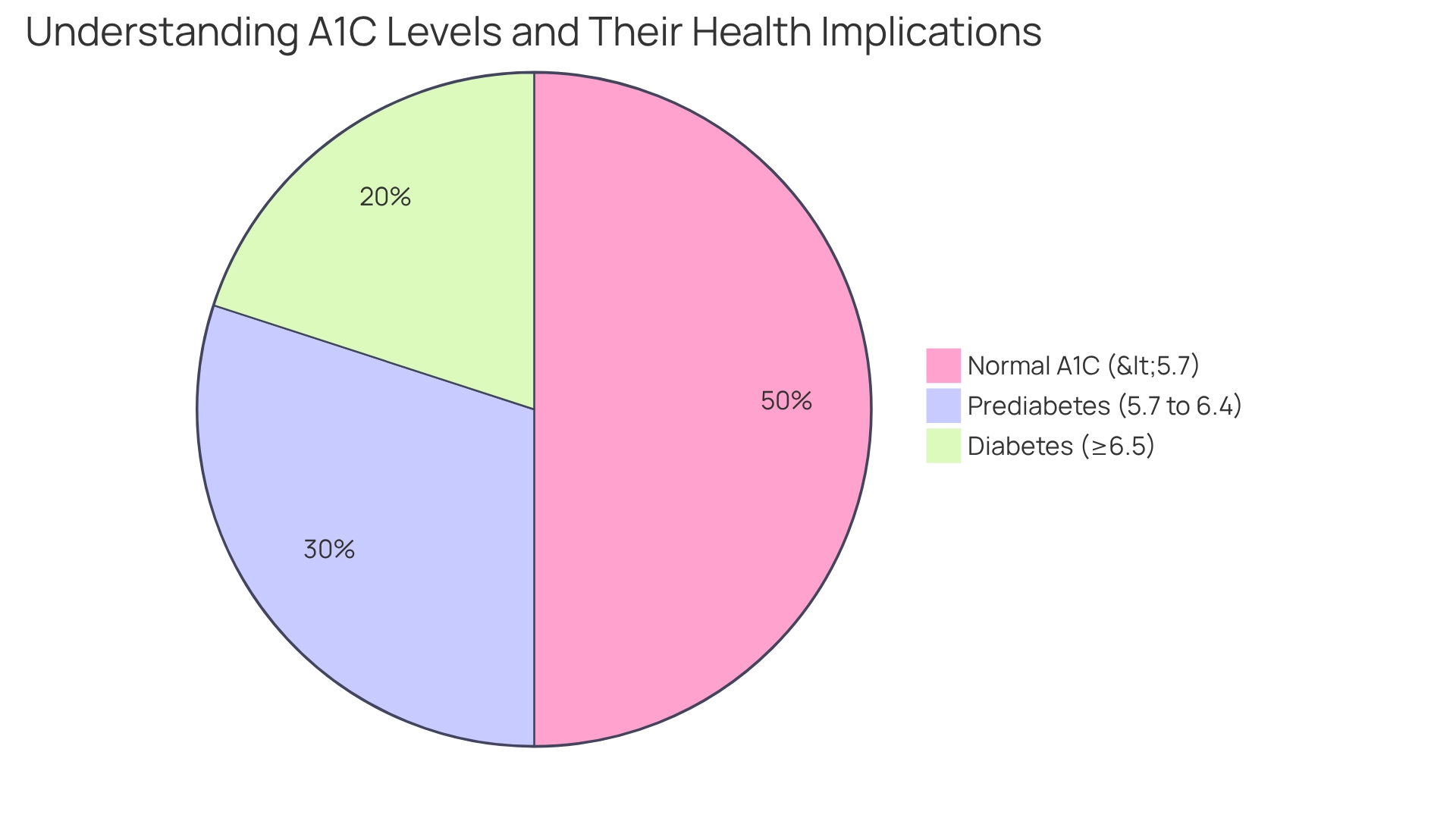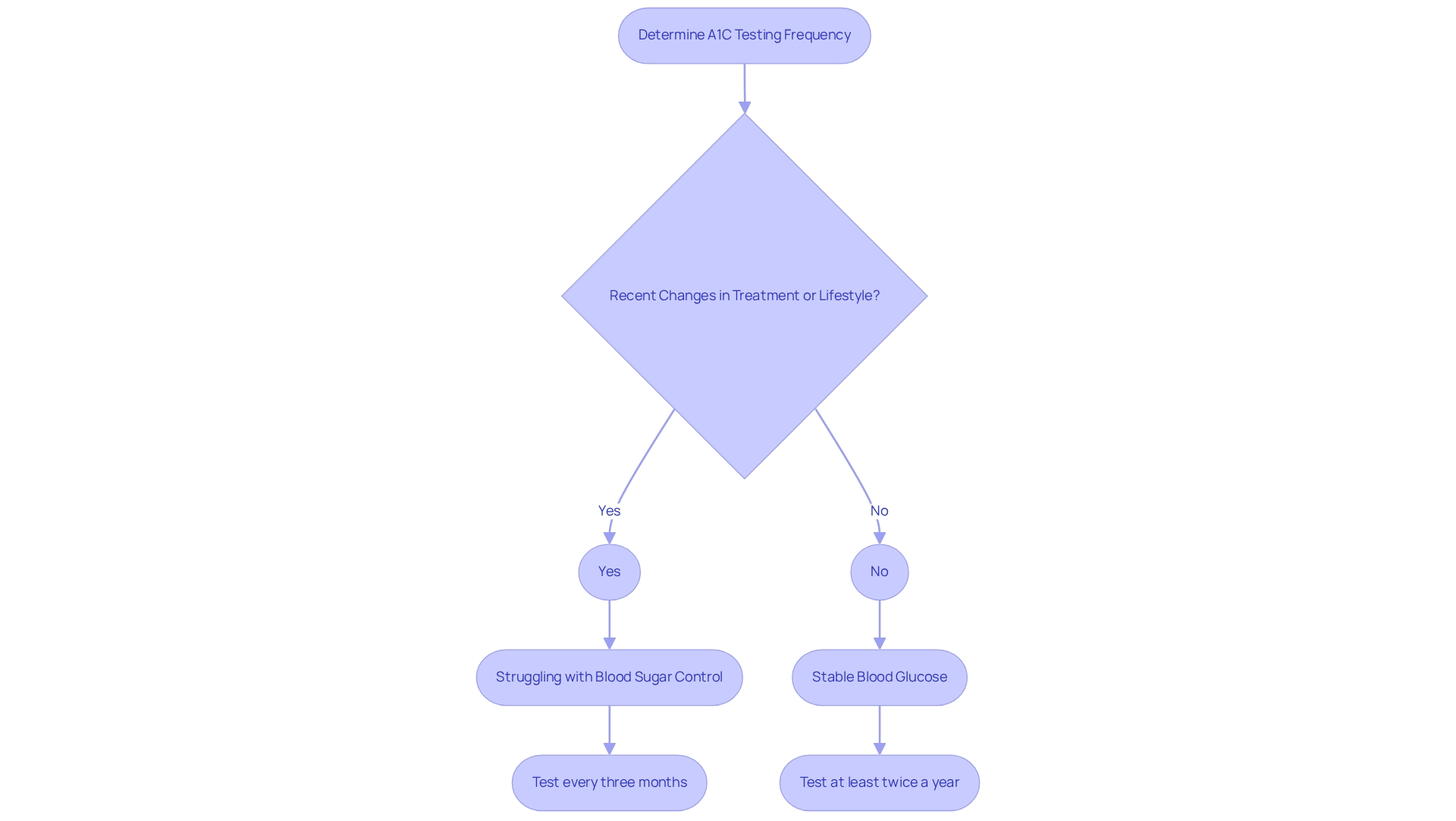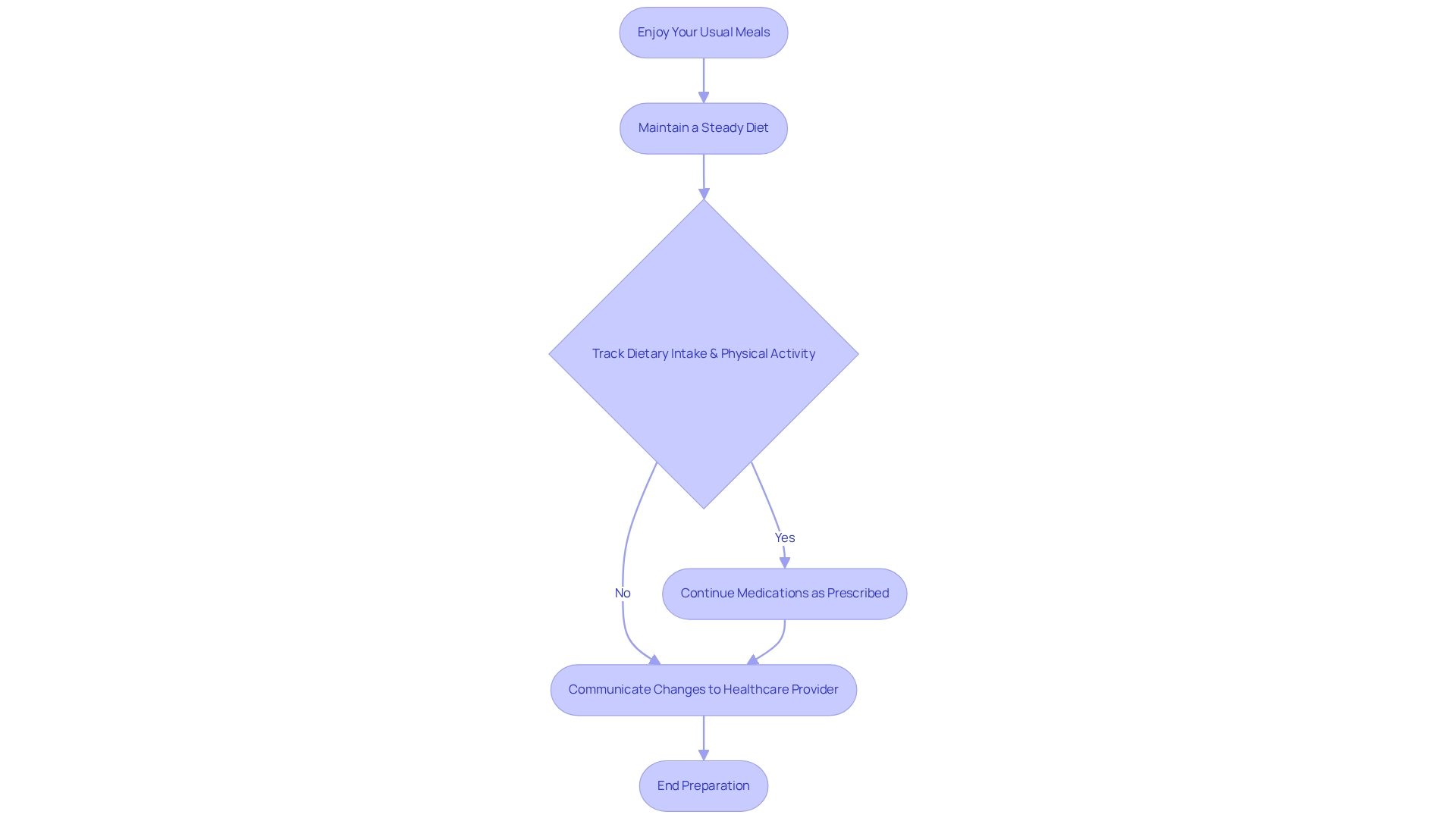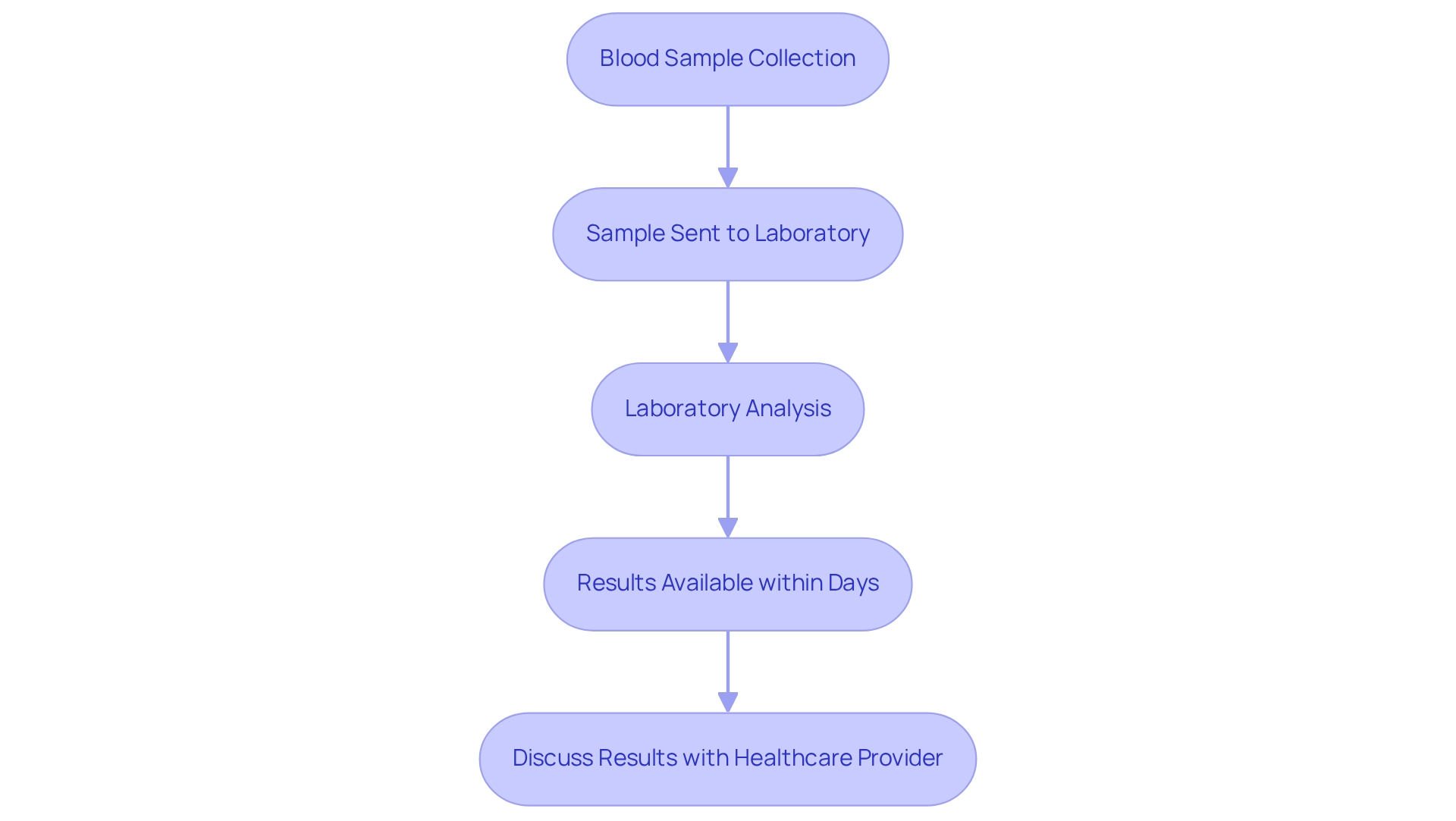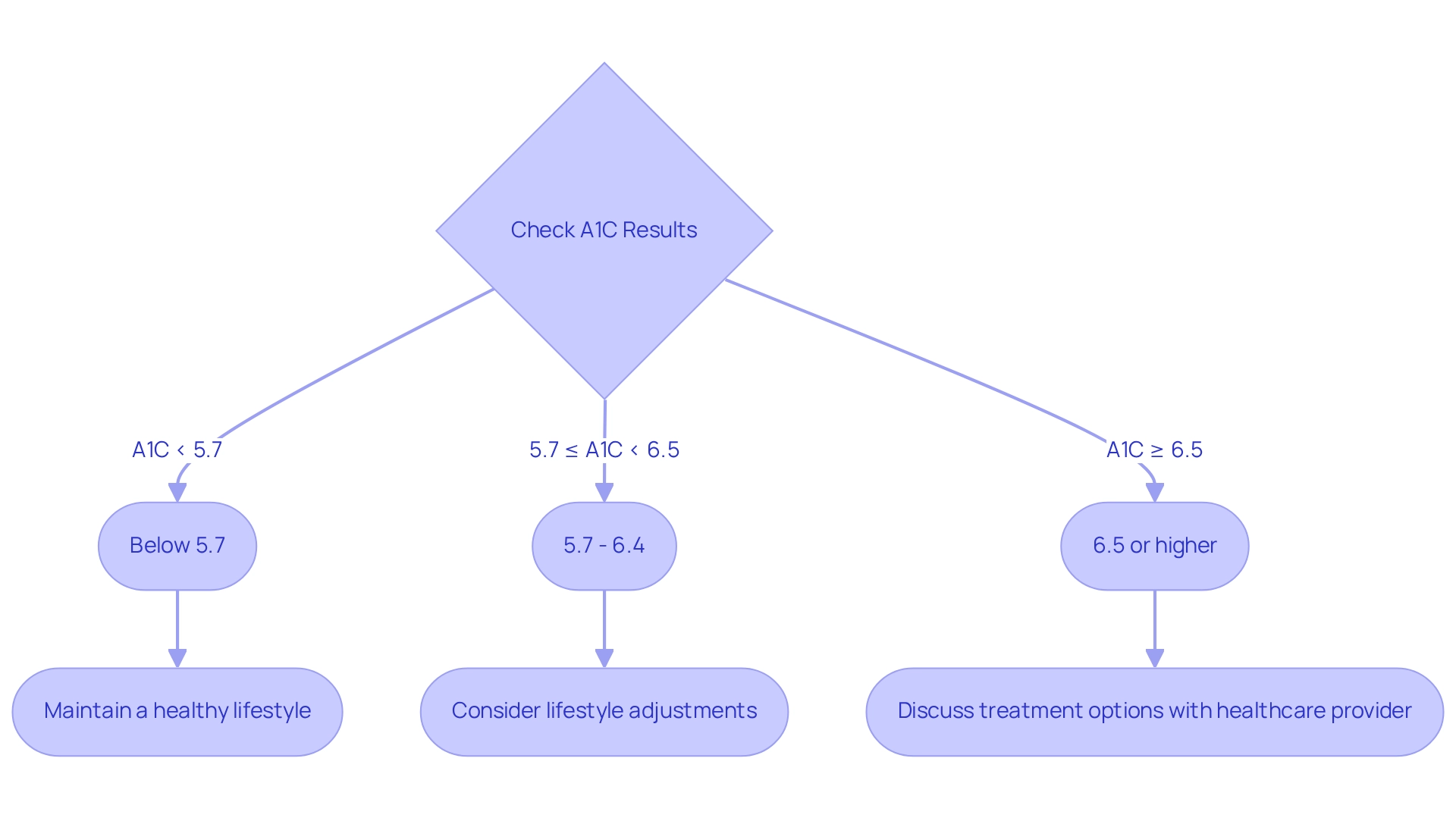Overview
Managing diabetes can be challenging, and understanding the frequency of A1C testing is a crucial step in this journey. For those with stable blood glucose levels, testing at least twice a year is recommended. However, if your levels fluctuate, you may need to test every three months. It’s important to recognize that each individual’s situation is unique, and this is where personalized care comes into play.
Many patients find that tailoring their testing schedule based on their health needs and treatment adjustments can make a significant difference. This approach not only helps in effectively managing diabetes but also provides a sense of control and reassurance. Remember, you are not alone in this journey; support is always available as you navigate through your health challenges.
As you consider your testing routine, think about what works best for you. Are there specific times when you feel more stable? Reflecting on these questions can help you and your healthcare provider create a plan that suits your lifestyle. Embracing this personalized approach can lead to better outcomes and a healthier future.
Introduction
In the realm of diabetes management, understanding the A1C test is crucial for both patients and healthcare providers. This essential tool measures average blood sugar levels over a two to three month period, offering critical insights that can influence treatment plans and health outcomes. It’s important to recognize that with a clear understanding of A1C ranges—normal, prediabetic, and diabetic—individuals can take proactive steps toward managing their health.
However, many patients find that they remain unclear about their results, highlighting the urgent need for educational resources. As experts advocate for regular testing and tailored care, real-life success stories illustrate the transformative power of informed decision-making in diabetes management. Embracing a holistic approach not only empowers patients but also fosters a supportive environment for reclaiming their health. Together, we can navigate this journey toward better health and well-being.
Understand the A1C Test and Its Importance
The A1C test, also known as the hemoglobin A1C test, plays a crucial role in managing blood sugar by assessing average glucose levels over the past two to three months. This test reveals a percentage that indicates the amount of glucose attached to hemoglobin, the protein found in red blood cells. Typically, a healthy A1C level is under 5.7%. Levels ranging from 5.7% to 6.4% suggest prediabetes, while a level of 6.5% or higher indicates diabetes-related conditions.
Understanding these ranges is vital for patients, as they can significantly influence health management strategies, especially in relation to A1C and how often it should be tested to track blood sugar levels. Many patients—over 50%—report feeling uncertain about their A1C results, which can hinder effective management of their condition. This underscores the need for educational resources that clarify the implications of A1C measurements.
Furthermore, a random blood sugar level of 200 mg/dL or above is also indicative of diabetes, reinforcing the importance of regular monitoring, including understanding A1C and how often patients should be tested to track long-term glucose control and adjust treatment plans as needed. Dr. Jason Shumard emphasizes the importance of empowering individuals with actionable insights, believing that such knowledge fosters an environment where people can reclaim their health and well-being.
Real-world examples illustrate the transformative impact of A1C testing on blood sugar management. For instance, M.L., a patient who faced challenges with diabetes for years, underwent a remarkable transformation after joining Dr. Shumard’s 30-Day Diabetes Reset program. After starting the program, M.L. lost 55 lbs, and their A1C values improved from 9.1 to 5.7, showcasing the effectiveness of personalized guidance and holistic care.
Furthermore, understanding A1C and how often to monitor can lead to improved health outcomes, as patients can make informed decisions about their lifestyle and treatment options. This proactive approach not only enhances their quality of life but also reduces reliance on conventional medical interventions, aligning with the center’s holistic philosophy. Dr. Shumard’s innovative strategy, highlighted in the case study ‘Challenging Traditional Healthcare,’ attracts individuals seeking effective solutions, reinforcing the significance of the A1C test within the broader context of managing blood sugar conditions.
Determine Your A1C Testing Frequency
Managing diabetes can be challenging, and understanding A1C how often testing is crucial for your health journey. For those with stable blood glucose readings, it’s generally recommended to have testing at least twice a year. However, if you find yourself adjusting your treatment plan or struggling with blood sugar control, more frequent testing—typically every three months—might be necessary.
It’s important to recognize that personalized care is at the heart of effective diabetes management. In 2025, expert recommendations emphasize the need for regular discussions with your healthcare provider to tailor your testing schedule to your unique health needs. For instance, if you’ve recently changed your medication or lifestyle, more frequent observation can help ensure you maintain optimal control of your condition. As Dr. Kirley noted, ‘Medicare coordinating its coverage with clinical guidelines of the U.S. Preventive Services Task Force and various payers will greatly simplify the process for physicians to implement these protocols.’ This highlights the importance of standardized testing procedures in enhancing care.
Many patients find that incorporating effective strategies for tracking progress and setting goals can further empower their diabetes management. Utilizing tools like fitness apps, journals, and pedometers can help you monitor your activity levels and establish SMART goals—specific, measurable, attainable, relevant, and time-bound. For example, aiming to increase your daily steps or exercise duration can significantly boost your motivation and accountability. Research shows that persistence in goal-setting can positively impact performance; for instance, scores improved from 3.4 (SD = 2.0) to 3.8 (SD = 1.9) in specific conditions, demonstrating the effectiveness of structured goal-setting. Regularly assessing your progress not only fosters a sense of accomplishment but also allows you to adjust your objectives as your fitness evolves.
Real-life examples illustrate how sticking to recommended A1C testing schedules can lead to better health outcomes. Patients who consistently test every three months often report improved control over their blood sugar levels. Case studies reveal that those who adhere to a structured testing frequency feel more empowered and informed about their health, enhancing their ability to manage their conditions effectively. Dr. Shumard’s educational resources, including books and seminars, play a vital role in this empowerment by providing you with the necessary knowledge to take charge of your health.
Additionally, it’s crucial to consider factors that can lead to falsely high A1C results, such as anemia and certain medications. Understanding these elements can help you and your healthcare provider make more informed decisions about A1C how often to test based on your condition. Engaging with your healthcare provider to establish a personalized testing schedule, along with adopting holistic lifestyle strategies like balanced nutrition and regular exercise, is essential for achieving optimal diabetes management.
Prepare for Your A1C Test
Preparing for your A1C test can feel daunting, but it’s reassuring to know that no fasting is required. You can enjoy your usual meals and beverages before the test. However, it’s important to maintain a steady diet in the days leading up to the test to help prevent fluctuations in your blood sugar levels. Many patients find that incorporating a balanced diet rich in fiber and nutrients—like seasonal fruits and vegetables—can significantly aid in regulating blood sugar effectively.
If you are on medications, please continue taking them as prescribed unless your doctor advises otherwise. Have you considered tracking your dietary intake and physical activity before the test? This practice can provide you with valuable insights into how often you should monitor your overall health management. It’s essential to communicate any recent changes in your health or medications to your healthcare provider, as these factors can influence your test results. Additionally, participating in community wellness initiatives may offer you support and resources tailored to managing blood sugar levels. This can enhance your readiness and confidence as you approach the A1C test. Remember, you are not alone in this journey, and there are many resources available to help you feel prepared and empowered.
Know What to Expect During the A1C Test
The A1C test is a simple procedure where a healthcare professional collects a small blood sample, usually from a vein in your arm. This process is quick and generally involves minimal discomfort, making it accessible for most patients. Once the blood sample is taken, it is sent to a laboratory for analysis, with results typically available within a few days. It’s important to recognize the timeline for obtaining your results; be sure to discuss with your healthcare provider how and when you will receive this information. Prompt results can greatly influence your management plan.
Many patients find that their experiences during the A1C testing process can vary, but many report feeling at ease due to the simplicity of the procedure. For instance, case studies indicate that individuals undergoing A1C testing during pregnancy often find the experience manageable, especially when they are informed about what to expect. This is particularly significant for women with risk factors for gestational conditions, as early detection can lead to improved outcomes. These experiences highlight the importance of regular A1C testing and emphasize how often it should be performed, not only for pregnant women but for all individuals managing type 2 diabetes, as it plays a vital role in monitoring and adjusting treatment plans.
Moreover, statistics reveal that about 1 in 10 Americans has diabetes, underscoring the necessity of regular A1C testing as part of a comprehensive diabetes management toolkit. Healthcare experts emphasize that when blood glucose readings are high, it indicates that the body is struggling to manage glucose effectively. Dr. Waring notes, “When your blood glucose is elevated to this level, it suggests your body is not regulating glucose effectively.” Therefore, being proactive about A1C testing can empower individuals to take control of their health and make informed decisions regarding their treatment options. By integrating regular testing with effective goal-setting strategies, patients can enhance their overall health management and work towards achieving their wellness objectives.
Interpret Your A1C Results and Take Action
Understanding your A1C results and knowing how often they are checked is a crucial step in managing your condition effectively. An A1C level below 5.7% is considered normal, indicating healthy blood sugar control. If your A1C is between 5.7% and 6.4%, you are categorized as prediabetic, highlighting the necessity for proactive lifestyle adjustments to prevent the onset of diabetes. An A1C of 6.5% or higher confirms a diagnosis of diabetes, necessitating a discussion with your healthcare provider about tailored treatment options.
Living with diabetes is a journey that can be approached with positivity and hope. Regardless of your A1C results, adopting a healthy lifestyle is paramount. This includes:
- Maintaining a balanced diet
- Engaging in regular physical activity
- Adhering to prescribed medications
Many patients find that by considering how often they actively respond to their A1C results through lifestyle modifications, they achieve notable health enhancements. For instance, endorsements from individuals who participated in Dr. Shumard’s 30-Day Diabetes Reset program demonstrate transformative results. One individual shared, “I lost 55 lbs. My A1C started at 9.1 after 8 months; it is now 5.7.” Another noted, “I feel so much better… I don’t need my meds anymore!” These narratives illustrate the beneficial effect of a comprehensive approach that addresses the underlying factors of type 2 diabetes, resulting in improved health and well-being.
Statistics indicate that a significant portion of individuals take action based on how often they monitor their A1C results, demonstrating the effectiveness of education and empowerment in managing diabetes. By interpreting A1C results accurately and understanding how often they need to be checked, individuals can make informed decisions that positively impact their health journey. Expert advice underscores the importance of viewing A1C levels not just as numbers, but as a guide for actionable steps toward better health. As Tiffany Danczak wisely said, “Don’t let yourself fall, you gotta pick yourself right up and strive to do better and be better! Think positive.” This holistic approach fosters a proactive mindset, encouraging patients to reclaim control over their diabetes management.
After interpreting your A1C results, consider discussing with your healthcare provider the specific lifestyle changes you can implement to improve your health outcomes. Additionally, it’s important to recognize the broader context of hospital safety concerns, as these can impact your overall health management. Taking these steps can lead to a more empowered and healthier life.
Conclusion
Understanding the A1C test and its significance is vital for effective diabetes management. This test not only measures average blood sugar levels over a two to three-month period but also provides a framework for patients and healthcare providers to make informed decisions about treatment plans. With clear knowledge of A1C ranges—normal, prediabetic, and diabetic—individuals can take proactive steps to manage their health and prevent complications. It’s concerning to note that over 50% of patients lack clarity regarding their A1C results, highlighting the necessity for educational resources aimed at demystifying this essential aspect of diabetes care.
Regular A1C testing, tailored to individual health circumstances, empowers patients to track their progress and adapt their management strategies effectively. Many patients find that engaging in open discussions with healthcare providers helps establish personalized testing schedules that reflect their unique needs. Moreover, incorporating goal-setting strategies and lifestyle changes can significantly enhance health outcomes, as demonstrated by real-world success stories. These narratives underscore the transformative potential of a holistic approach to diabetes management, emphasizing that informed decision-making can lead to remarkable improvements in one’s health.
In conclusion, embracing the A1C test as a cornerstone of diabetes management not only fosters a deeper understanding of personal health but also cultivates an environment of empowerment and proactive care. By interpreting results accurately and taking decisive action, individuals can navigate their diabetes journey with confidence and optimism, ultimately reclaiming control over their health and well-being.
Frequently Asked Questions
What is the A1C test and why is it important?
The A1C test, also known as the hemoglobin A1C test, measures average blood glucose levels over the past two to three months. It indicates the percentage of glucose attached to hemoglobin in red blood cells, which is crucial for managing blood sugar levels.
What do the A1C level ranges indicate?
A healthy A1C level is under 5.7%. Levels between 5.7% and 6.4% suggest prediabetes, while an A1C level of 6.5% or higher indicates diabetes-related conditions.
How often should A1C testing be done?
It is generally recommended to test at least twice a year for those with stable blood glucose levels. However, if treatment plans are being adjusted or if blood sugar control is a struggle, testing every three months may be necessary.
What factors influence the frequency of A1C testing?
Factors such as recent changes in medication, lifestyle, or blood sugar control can influence how often A1C testing should be performed. Regular discussions with a healthcare provider can help tailor the testing schedule to individual health needs.
What are the benefits of understanding A1C results?
Understanding A1C results can empower patients to make informed decisions about their lifestyle and treatment options, leading to improved health outcomes and a better quality of life.
How can patients track their progress in managing diabetes?
Patients can utilize tools like fitness apps, journals, and pedometers to monitor activity levels and set SMART (specific, measurable, attainable, relevant, and time-bound) goals, which can enhance motivation and accountability in managing their condition.
What can cause falsely high A1C results?
Factors such as anemia and certain medications can lead to inaccurately high A1C results, which is why it’s important for patients to discuss these with their healthcare provider for a more accurate assessment.
How does personalized care impact diabetes management?
Personalized care is essential for effective diabetes management, as it allows for tailored testing schedules and lifestyle strategies that align with individual health needs, thereby improving overall control of the condition.
